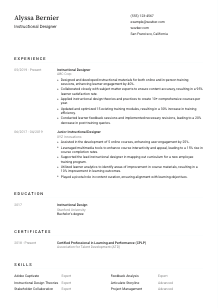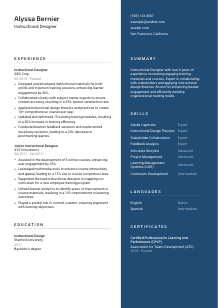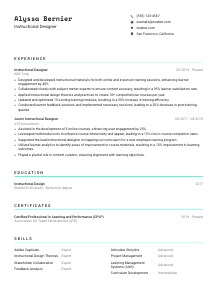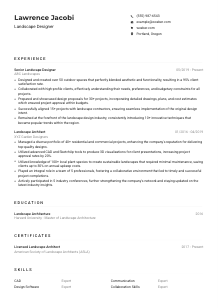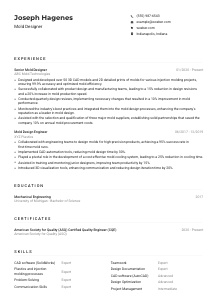Instructional Designer Resume Example
Shaping learning pathways, but your resume seems off-course? Dive into this Instructional Designer resume example, crafted with Wozber free resume builder. See how you can architect your educational expertise to align with company standards, letting your career flourish as brilliantly as your lesson plans!

How to write an Instructional Designer resume?
Embarking on the journey to land your dream role as an Instructional Designer requires more than expertise in developing engaging learning experiences. It demands a resume that not only speaks to your qualifications but does so in a way that resonates with hiring managers and passes the scrutinous eyes of Applicant Tracking Systems (ATS). Leveraging Wozber's free resume builder, this guide will walk you through the creation of an ATS-compliant resume tailored uniquely to an Instructional Designer position.
Ready to mold your professional story into a compelling narrative that opens doors? Let's dive in and make your resume not just seen, but remembered.
Personal Details
The opening section of your resume is akin to a firm handshake at the beginning of an interview. It sets the stage for what's to come. By refining your personal details with precision, you ensure this initial interaction with hiring managers is impactful.
1. Embrace Your Brand
Start with your name, prominently displayed. This isn't just about font size; it's about owning your identity in the professional world. Consider the space under your name the prime real estate for stating 'Instructional Designer' - immediately associating your name with the role you're eyeing.
2. Title Translation
Below your name, align your professional title with the role you're pursuing. This isn't mere repetition but a strategic placement. When you position "Instructional Designer" beneath your name, you're sending a clear message to the hiring manager and the ATS: "This is the role I'm crafted for."
3. The Contact Conundrum
In this digital age, your contact details must be correct and professional. A mistyped phone number or a quirky email address can cost you an opportunity. Stick to a professional email format, ideally firstname.lastname@email.com, and double-check your digits to ensure they're accurate.
4. Location, Location, Location
For the Instructional Designer job insisting on candidates being located in San Francisco, California, highlighting your San Francisco residency upfront meets a critical requirement at a glance. It reassures the employer of your availability and fit for the role without them having to search.
5. Digital Footprint
If you have a professional profile or personal website showcasing your instructional design projects or portfolio, include it here. This is not just about providing more content for hiring managers but about demonstrating your ability to create and share content digitally, a key skill for any Instructional Designer.
Takeaway
The personal details section is your resume's North Star, guiding the hiring manager through your professional landscape. By perfecting this section, you affirm your identity, readiness, and suitability for the Instructional Designer role. Think of it as more than just information; it's the prelude to your professional narrative.





Experience
The Experience section is where your resume starts to showcase its depth. For Instructional Designers, this is your arena to demonstrate not merely what you've done, but how you've excelled and impacted the educational landscape.
- Designed and developed instructional materials for both online and in‑person training sessions, enhancing learner engagement by 40%.
- Collaborated closely with subject matter experts to ensure content accuracy, resulting in a 95% learner satisfaction rate.
- Applied instructional design theories and practices to create 10+ comprehensive courses per year.
- Updated and optimized 15 existing training modules, resulting in a 30% increase in training efficiency.
- Conducted learner feedback sessions and implemented necessary revisions, leading to a 20% decrease in post‑training queries.
- Assisted in the development of 5 online courses, enhancing user engagement by 25%.
- Leveraged multimedia tools to enhance course interactivity and appeal, leading to a 15% rise in course completion rates.
- Supported the lead instructional designer in mapping out curriculum for a new employee training program.
- Utilized learner analytics to identify areas of improvement in course materials, resulting in a 10% improvement in learning outcomes.
- Played a pivotal role in content curation, ensuring alignment with learning objectives.
1. Connect the Dots
Dissect the job description to highlight experiences directly relevant to the role. Your goal is to map your journey in a way that reflects you're not just an Instructional Designer but one tailor-made for the specific demands of this position.
2. Structure is Key
Maintain a clean, chronological layout starting with your most recent role. Use this structure to your advantage, ensuring each role listed ties back to the core skills and responsibilities of an Instructional Designer as outlined in the job description.
3. Narrate Your Impact
Employ accomplishment statements to breathe life into your experiences. Instead of a task list, detail how you designed and developed instructional materials that enhanced learner engagement, collaborated with experts for content accuracy, or innovated with eLearning software. Numbers speak volumes; use them to quantify your achievements.
4. Relevance Over Recency
While your most recent role is important, relevance to the Instructional Designer position takes precedence. If an earlier role more closely aligns with the job description, make sure its accomplishments and used skills are emphasized.
5. Professional Development
Include evidence of your growth and learning in the instructional design field, whether through formal roles, freelance projects, or significant contributions to community or non-profit educational initiatives. This demonstrates not just your skill set but your dedication to the profession.
Takeaway
The experience section is where your professional narrative comes to life. It's an opportunity to showcase your successes and how they've prepared you for this next step. Craft this section with care, ensuring every word speaks to your achievements, capabilities, and fit for the role of an Instructional Designer.
Education
While instructions design might seem like a field driven purely by creativity and technical skills, your educational foundation plays a crucial role in establishing your credentials and understanding of fundamental theories.
1. Highlight Relevant Degrees
The job description's call for a Bachelor's degree in Instructional Design, Education, or a related field isn't just a formality. It's a signal of the theoretical foundation necessary for success in this role. Reflect this requirement directly in your resume to resonate with the job's educational prerequisites.
2. Keep It Straightforward
Your education section should be a beacon of clarity within your resume. List your degree, the institution where you received it, and your graduation date. This straightforward approach aids the ATS in easily identifying and validating your qualifications.
3. Tailoring for the Role
Where applicable, align your degree and coursework details specifically with the job. If your degree is directly in Instructional Design or a closely related field, make sure this is explicitly stated. This alignment not only meets the specified criteria but highlights your focused educational pathway.
4. Relevant Courses and Projects
If you're early in your career or if your degree is in a broader field, consider mentioning specific courses or projects that demonstrate your dedication and skill relevant to instructional design. This can provide a more detailed picture of your background and areas of expertise.
5. Continual Learning
The field of Instructional Design evolves rapidly, and so should your knowledge. If you've taken additional courses, workshops, or certifications beyond your degree that enhance your capabilities as an Instructional Designer, this section is a great place to showcase that continued educational commitment.
Takeaway
In a role that so elegantly blends creativity with educational science, your educational background is not just a list of qualifications. It's evidence of your commitment to understanding the foundational theories and practices that make effective instructional design possible. Ensure your education section clearly communicates your qualifications and dedication to the field.
Certificates
In the world of Instructional Design, certifications can serve as a powerful testament to your skills, dedication, and ongoing professional development. Let's explore how to effectively highlight these accomplishments.
1. Key Certifications First
When it comes to certifications, prioritization is crucial. The job description hints at the value of the Certified Professional in Learning and Performance (CPLP) certification. If you hold this or similar esteemed certifications, let them take the forefront in your resume.
2. Alignment with Role Requirements
Choose to list certifications that directly align with the instructional design role you're applying for. This focused approach ensures your resume presents you as not just qualified, but exceptionally well-prepared for the specific demands of the position.
3. Dates Matter
Include the acquisition date or validity period of your certifications, particularly if they are recent or require renewal. This transparency showcases not only your achievements but also your commitment to keeping your skills sharp and up to date.
4. Commitment to Growth
Your certifications are a clear signal of your dedication to professional growth and excellence in the field of instructional design. Regularly revisiting and updating this section to include new certifications demonstrates an ongoing commitment to your profession.
Takeaway
Certifications are more than just accolades; they're a narrative of your journey towards excellence and specialization in instructional design. By thoughtfully selecting and presenting these accomplishments, you offer a compelling glimpse into your professional ethos and dedication to continual improvement.
Skills
In the realm of Instructional Design, your skills section is a compact showcase of the tools, methodologies, and competencies you bring to the table. Let's ensure your skills section speaks volumes to hiring managers.
1. Decipher the Job Description
The job description is your treasure map to understanding which skills are most valued by the employer. Skills like proficiency with eLearning software (Articulate Storyline, Adobe Captivate), strong project management, and knowledge of instructional design theories are explicitly mentioned. Make these your headline acts.
2. Match and Highlight
Once you've identified the core skills needed for the role, audit your own skill set. Match your skills with those requested, prioritizing those that are most relevant and setting them at the forefront of your skills section.
3. Quality Over Quantity
Your skills section shouldn't be a laundry list of everything you can do; instead, it should be a carefully curated collection that underscores your suitability for the Instructional Designer role. Prioritize quality and relevance over sheer numbers to keep the focus sharp.
Takeaway
Your skills are a reflection of your professional toolkit. In the context of your resume, they're a promise of the value you'll bring to the table. Handpick each skill with the aim of showcasing your best self – an Instructional Designer of high caliber, ready to meet and exceed job expectations.
Languages
In a field where clear communication is paramount, your ability to converse and create in multiple languages can be a significant asset. This section will guide you in presenting your linguistic skills in a way that resonates with Instructional Designer roles.
1. Identify Job Language Requirements
The job calls for "Proficiency in English." Start by ensuring this requirement is clearly met in your resume. If English is your native language or you're highly proficient, state this prominently.
2. Prioritize and List
After meeting the primary language requirement, list any additional languages you speak. This can showcase your ability to potentially design instructional content for a diverse, multilingual audience, an invaluable skill in today's globalized learning environments.
3. Accurate Proficiency Levels
Be precise about your language proficiency levels. Use universally understood terms like 'Native,' 'Fluent,' 'Intermediate,' or 'Basic' to describe your proficiency in each language listed. This clarity helps hiring managers gauge your ability to communicate and instruct in different linguistic contexts.
4. Relevance to Role Scope
Consider the scope of the Instructional Designer role. If the position involves creating materials for an international audience or for learners of different linguistic backgrounds, your multilingual skills could set you apart as an exceptionally versatile candidate.
5. Continuous Improvement
Language skills, much like professional skills, require ongoing cultivation. Showcasing your commitment to improving and expanding your linguistic abilities reflects a broader dedication to personal and professional growth.
Takeaway
Languages are more than a means of communication; they're a tool for connecting with a diverse learning audience. In showcasing your linguistic capabilities, you position yourself as an Instructional Designer capable of transcending barriers and creating universally engaging content. Let your linguistic skills underline your readiness to engage with global learners.
Summary
The summary section is your chance to captivate the hiring manager's attention right from the start. Here, we'll weave together the threads of your Instructional Design journey into a narrative that's both compelling and reflective of your professional identity.
1. Absorb the Job's Essence
Begin by internalizing the essence of the Instructional Designer role. Understand what the job entails and what the employer values most. This initial step is crucial for crafting a summary that speaks directly to the needs and expectations outlined in the job description.
2. A Confident Opening
Your summary should open with a strong, self-assured statement of your professional identity. "Instructional Designer with over 6 years of experience..." sets the tone of confidence and introduces you as a seasoned professional ready for the challenges this role might present.
3. Highlight Key Attributes
In a few lines, present your standout skills and notable accomplishments that directly align with what the job description demands. This isn't just about listing your skills but illustrating them through your professional achievements.
4. Conciseness is Your Friend
While it may be tempting to include every achievement and skill, the summary is about brevity and impact. Aim for 3-5 lines that encapsulate your professional identity, leaving the reader eager to learn more about how you've applied your skills and knowledge.
Takeaway
Your professional summary is the opening act of your resume, setting the stage for the detailed narrative to follow. By focusing on relevancy, accomplishments, and concise expression, you make a strong initial impression. This section is your elevator pitch – make it count, and let it reflect the essence of your potential as an Instructional Designer.
Launching Your Instructional Designer Journey with Wozber
Equipped with these insights and guided by Wozber's free resume builder, including ATS-friendly resume templates and ATS resume scanner, you're now poised to create a resume that not only meets the requirements of an Instructional Designer role but surpasses expectations. Remember, your resume is not just a document; it's your professional story waiting to be told. Fine-tune it with attention to detail and a strategic approach to ATS optimization. Let Wozber be the cornerstone of your resume-building journey, and step boldly towards your next big opportunity.
Your ability to craft compelling learning experiences is about to take you places. Let's get started!

- Bachelor's degree in Instructional Design, Education, or a related field.
- Minimum of 3 years experience in instructional design or curriculum development.
- Proficiency with eLearning software such as Articulate Storyline or Adobe Captivate.
- Strong project management skills with the ability to manage multiple projects simultaneously.
- Certified Professional in Learning and Performance (CPLP) certification preferred.
- Proficiency in English is key.
- Must be located in San Francisco, California.
- Design and develop instructional materials for both online and in-person training sessions.
- Collaborate with subject matter experts to ensure content accuracy and relevance.
- Apply instructional design theories and practices to create engaging learning experiences.
- Evaluate and update existing training materials to meet the needs of the organization and its learners.
- Conduct learner feedback sessions and make necessary revisions to training materials.





